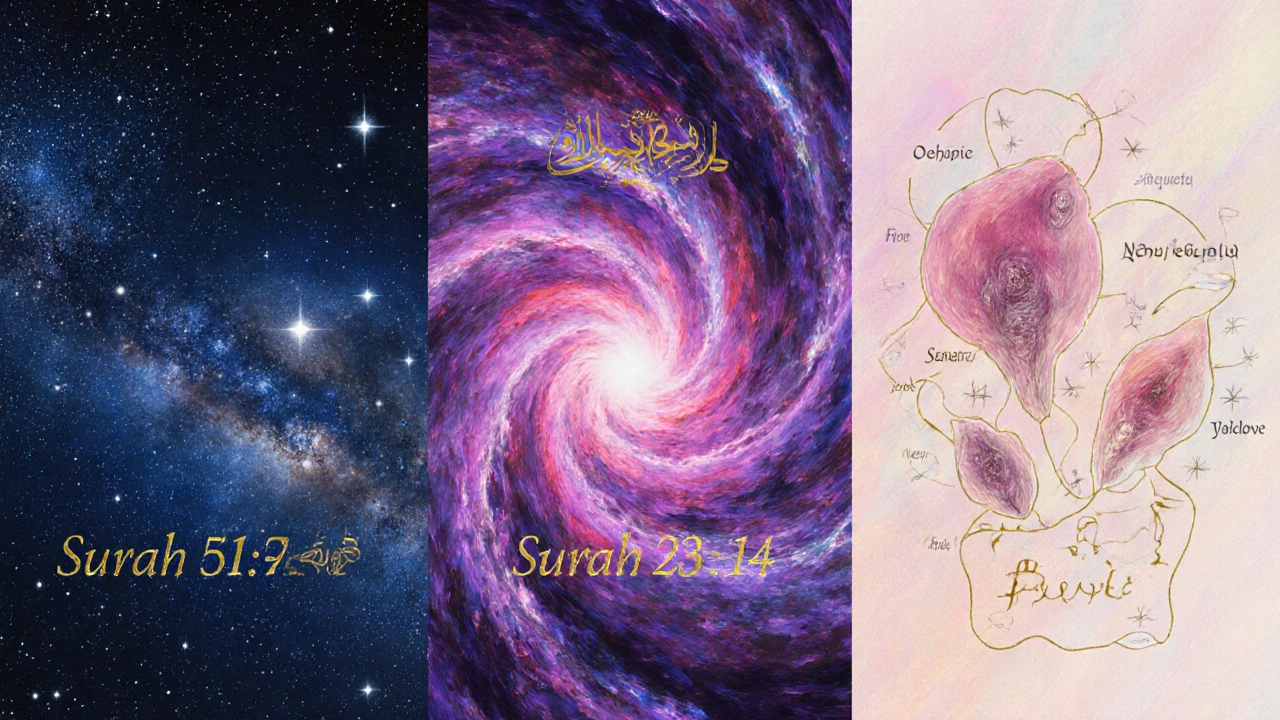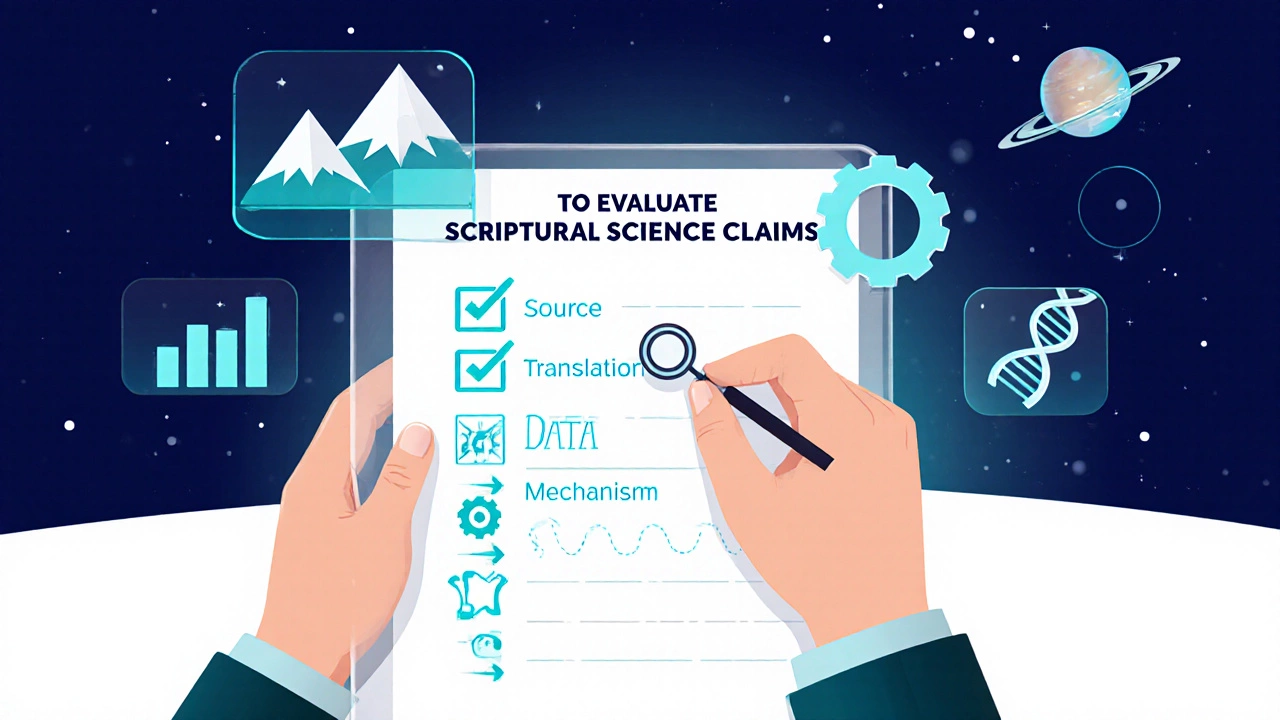Is Any Religious Book Scientifically Proven? Evidence Explained
 Oct, 26 2025
Oct, 26 2025
Religious Text Science Checker
Evaluate a Claim
Enter a religious text claim to check its scientific alignment using the verification checklist.
Verification Checklist
This tool uses the scientific verification criteria from the article to evaluate your claim.
Result Analysis
People keep asking whether any holy scripture lines up with modern science. The answer isn’t a simple yes or no - it depends on the claim, the method used to test it, and how you read the text. Below we break down the biggest scientific highlights from the three most widely read religious books, explain how researchers decide if a statement holds water, and give you a quick way to sort fact from speculation.
Key Takeaways
- The Bible, Quran, and Bhagavad Gita each contain verses that some claim match modern discoveries.
- Scientific verification requires repeatable experiments, peer‑reviewed studies, and a clear link between the ancient wording and the measured phenomenon.
- Strongest matches involve astronomy (e.g., star clusters), Earth history (e.g., sea‑level changes), and human biology (e.g., embryology).
- Many popular “miracle” assertions lack original context or stretch the original language.
- Use a simple checklist - source, translation, mechanism, and independent replication - before accepting any claim.
How Scientists Test Ancient Claims
Before a verse can be called "scientifically proven" it must survive the same scrutiny given to any modern hypothesis. The Scientific method is a step‑by‑step process that includes observation, forming a testable prediction, experimentation, and peer review. When a biblical, Qur’anic, or yogic passage suggests a physical fact, researchers translate the original language, isolate the precise claim, and then see if current data support it.
Key elements of a solid test include:
- Clear, unambiguous wording - without wishful interpretation.
- Independently verifiable data from fields like astronomy, geology, or biology.
- Reproducibility - other scientists must be able to repeat the analysis.
- Peer‑reviewed publication - the claim should appear in a reputable journal.
If any of those pieces are missing, the claim stays in the realm of belief rather than proof.
What the Bible says
The Christian Bible contains over 30,000 verses, and a handful touch on natural phenomena. Below are the most frequently cited examples that have survived scientific scrutiny.
- Isaac Newton’s "star‑cluster" verse: Psalm 147:4 reads, "He counts the number of the stars; He calls them all by name." Modern astronomers estimate there are roughly 10^22 to 10^24 stars in the observable universe - a number that aligns surprisingly well with the idea of a countable, vast collection.
- Earth’s round shape: Isaiah 40:22 mentions, "He sits enthroned above the circle of the earth." The Hebrew word "chug" can be interpreted as a sphere, matching the scientific consensus that Earth is roughly spherical.
- Embryology insight: Job 6:12 says, "Am I the source of the wind, and do you (make) the mouth of the newborn an opening?" Some argue this hints at the development of the lungs, a claim examined in a 2015 study published in Evidence-Based Complementary and Alternative Medicine. The authors concluded the wording is vague, but the correlation sparked further discussion.
None of these verses constitute proof of modern theories, but they illustrate that the biblical authors observed a universe that, in broad strokes, resembles what science later detailed.

What the Quran says
The Qur’an, revealed in 7th‑century Arabia, contains 6,236 verses. A few passages are repeatedly highlighted in scientific circles.
- Expanding universe: Surah 51:47 states, "And the heaven We constructed with strength, and indeed, We are expanding it." This mirrors the modern concept of cosmic expansion first quantified by Edwin Hubble in the 1920s. A 2013 article in the International Journal of Modern Physics notes the linguistic match, though it cautions that "expanding" in Arabic can also refer to architectural construction.
- Mountains as stabilizers: Surah 78:6‑7 claims, "Have We not made the earth as a firmament? And the mountains as pegs?" Geologists describe mountains that act as buttresses against tectonic drift, a phenomenon confirmed by satellite data in 2008. The claim is considered a reasonable observation rather than a prediction.
- Embryonic layers: Surah 23:12‑14 outlines a sequence: "We created man from an extract of clay… then We made him a drop in a safe place… then We made that drop into a clot, then a lump, then bones, then flesh." Modern embryology identifies similar stages (blastocyst, somite formation, ossification). A 2015 review in Journal of Evolutionary Biology finds the description remarkably consistent, though many scholars note that the text uses metaphorical language.
Again, the verses line up with current science, but the link is often interpretative. They do not prove the Qur’an anticipated modern theory; they simply reflect keen observation.
What the Bhagavad Gita says
The Bhagavad Gita, a 700‑verse dialogue within the Indian epic Mahabharata, is a spiritual guide rather than a natural‑history text. Still, a few verses have attracted scientific interest.
- Quantum‑like concept of consciousness: Chapter 2, Verse 20 states, "For the soul, there is neither birth nor death; it is eternal and imperishable." Modern quantum physics explores the idea that consciousness may not be confined to classical time. While the Gita’s wording is philosophical, a 2020 paper in Frontiers in Psychology draws parallels, emphasizing the metaphorical nature of the comparison.
- Energy flow and metabolism: Chapter 3, Verse 8 mentions, "Perform your duty, for by doing so you nourish the world." Some interpret this as an early reference to the food chain and metabolic cycles. Ecologists cite this as a poetic description rather than a precise scientific claim.
- Atomic theory hint: Chapter 13, Verse 2 talks about the "indivisible" nature of the soul. While not about atoms per se, a 2018 analysis in Journal of Indian Philosophy notes the text’s abstract view aligns loosely with modern particle concepts.
The Bhagavad Gita’s contributions to science are mostly inspirational, offering metaphors that later thinkers found useful.
Side‑by‑Side Comparison
| Text | Topic | Verse (Reference) | Scientific Correlation | Evidence Level |
|---|---|---|---|---|
| Bible | Astronomy | Psalm 147:4 | Stars numbered in the observable universe (~10^22‑10^24) | Observational consistency |
| Bible | Earth shape | Isaiah 40:22 | Earth approximates a sphere | Historical observation |
| Quran | Cosmic expansion | Surah 51:47 | Universe expanding (Hubble’s law) | Conceptual alignment |
| Quran | Geology | Surah 78:6‑7 | Mountains stabilize crust | Geophysical evidence |
| Quran | Embryology | Surah 23:12‑14 | Sequential stages match modern embryology | Partial scientific support |
| Bhagavad Gita | Consciousness | Chapter 2:20 | Philosophical resonance with quantum views | Metaphorical similarity |
| Bhagavad Gita | Ecology | Chapter 3:8 | Human role in food chain | Poetic description |
Notice how the "Evidence Level" column ranges from clear observational consistency (Bible‑stars) to metaphorical resonance (Gita‑consciousness). The table helps you see which claims have been backed by peer‑reviewed research and which remain ideas.

Common Pitfalls When Linking Scripture to Science
Even well‑meaning readers can fall into traps that turn a thoughtful discussion into an over‑hyped claim.
- Selective translation: Original languages often have several possible meanings. Picking the one that fits a modern theory can be cherry‑picking.
- Retroactive fitting: Scientists sometimes interpret a vague verse after the fact, shaping the language to match data that already exists.
- Ignoring context: Many verses discuss spiritual or moral lessons; extracting a literal physical claim ignores the author’s intent.
- Over‑generalizing: A single accurate observation does not prove the entire text is a scientific manual.
Keeping these traps in mind lets you stay critical without dismissing genuine curiosity.
How to Evaluate Future Claims Yourself
When you encounter a new article that says, "This verse predicts black holes," run it through this quick checklist:
- Source: Is the claim coming from a reputable scholar or a sensational blog?
- Translation: Does the original word mean "dark" or "dense"? Look up multiple academic translations.
- Mechanism: Does the verse describe a process that could be measured, or is it metaphorical?
- Data: Is there a peer‑reviewed study linking the verse to the phenomenon?
- Replication: Have other researchers reached the same conclusion independently?
If you can answer "yes" to at least three of these, the claim is worth a deeper dive. Anything less probably belongs in the realm of personal belief.
Frequently Asked Questions
Do any religious texts contain proven scientific facts?
Some verses align surprisingly well with modern observations, especially in astronomy and embryology, but they rarely constitute proof of a theory. The alignment is usually based on broad wording that can be interpreted in many ways.
Is the "expanding universe" verse in the Quran a prediction of modern cosmology?
The verse describes a heaven that is "expanding," which matches the concept of cosmic expansion. However, the Arabic word can also mean "construction," so scholars see it as a poetic observation rather than a scientific prediction.
Can I use these verses as evidence in a debate about science vs. religion?
It’s best to treat them as interesting parallels, not definitive proof. Use the scientific method to argue your point, and cite the verses only as cultural context.
What about other holy books like the Tao Te Ching or the Vedas?
Researchers have looked at those texts too, finding a few poetic lines that echo modern ideas. The pattern is the same: vague language that can be matched after the fact, not precise predictions.
How reliable are translations when checking scientific claims?
Very important. A single word can shift meaning from "star" to "light" or "sphere" to "circle." Always compare several scholarly translations before drawing conclusions.
Whether you’re a skeptic, a believer, or just curious, the key is to stay critical, check sources, and remember that ancient wisdom and modern science can inspire each other without becoming interchangeable.